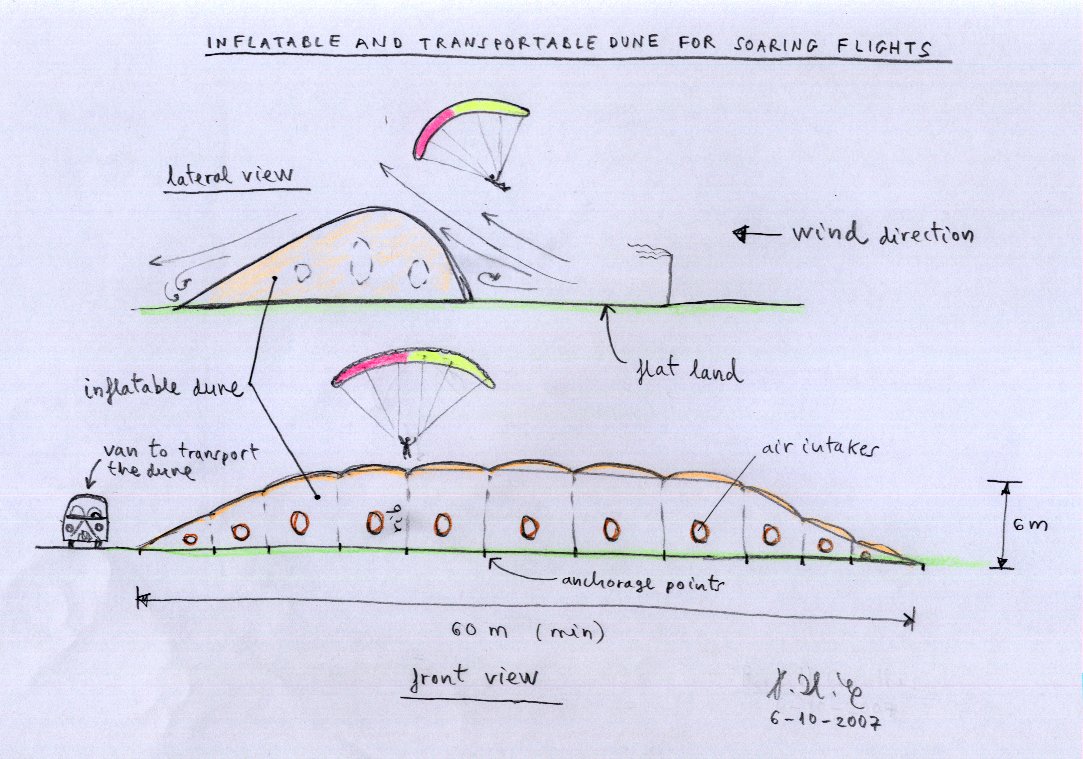
INFLATABLE AND TRANSPORTABLE DUNE FOR SOARING FLIGHTS
(groundhandling & free-style)


The 22 of September were published the interesting post “Portable-slope for Hang Gliders” in "Yahoo Groups Hang Gliding Museum". It is spoken of the possibility of using an inflated tube as portable slope and asks if somebody has tried the system.
Seeing the interest of the idea, I have drawn what I believe that it could be a practical and portable dune to make PG and HG flights in completely flat places and moderate winds. The dune would have the aspect of a great paraglider of few cells and convex-flat profile of great thickness, anchored in the ground. The dune would be made with light fabric and could be transported in a van until a flat and free place of obstacles to be mounted perpendicularly to the wind direction.
I have received some interesting contributions from the "Yahoo Groups Hang Gliding Museum" and from "Paragliding forum".
Some have suggested to install the headquarters of competition inside the dune, employee like great tent.
Others have objected that would be necessary several elephants to maintain the dune in their site and that does not take the wind to it, but making simple calculations it is verified that it would be sufficient to anchor the dune to the ground with few steel bars:
The dynamic pressure of the wind on a surface can be calculate on approximated form by the formula:
w (kg/m2) = [v (m/s) *v (m/s) /16]
Considering a max. wind speed of 50 km/h (13.89 m/s), that is far beyond the usable one, is obtained:
w=13,89*13,89/16=12,06 kg/m2
Considering a dune of 6 ms of height:
12,06 kg/m2 * 6 ms =72,36 kg by linear meter of dune
Considering a coefficient Cx of the dune between 0.6 is 0,8:
p= 72.36 kg *0,8 = 57.89 kg
Considering a dune of 100 ms of length:
57.89 100 kg * = 5789 kg, that is approximately the weight of an elephant. Despite considering a coefficient of friction of 0.5 between the ground and the elephant, would be necessary at least two elephants to hold the dune of 100 m with a wind of 50 km/h... Another more simple solution but is to anchor steel bars of 12 mm of diameter each 5 ms (to support 5*57,89=289 kg of shear effort, that steel resist without problems.
Others have objected, with good arguments, that if the dune is constructed with paraglider fabric, its cost, weight, and volume, they would be excessive. The problem of the cost, can be solved using an alternative material type polyethylene. The data shown in the table summary show that the weight and the volume enter within the reasonable thing. The problem of the weight and the volume can be simplified transporting the dune in in two or three parts.
The utility of the dune would be practices and training in flat zones, "groundhandling", "free-style" and simply, to have fun! The dune could occasionally be installed in beaches, parks, and exposed explanades affluents to the wind, in great cities.
Still there is much to study on the inflatable and transportable dune! Suggestions are accepted.| INFLATABLE AND TRANSPORTABLE DUNE | |
| Height of the dune | 6 m |
| Length of the dune | > = 60 m |
| Profile | Convex-flat of great thickness |
| Perimeter of the profile | 42 m |
| Area of the profile | 70 m2 |
| Perimetral surface of the dune | 2520 m2 |
| Surface of inner profiles | 840 m2 |
| Total surface | 3360 m2 |
| Gross weight (using 40gr/m2) | 135 kg |
| Folded total volume (ratio of 50 l by 4 kg) | 1688 l (1,7 m3) |